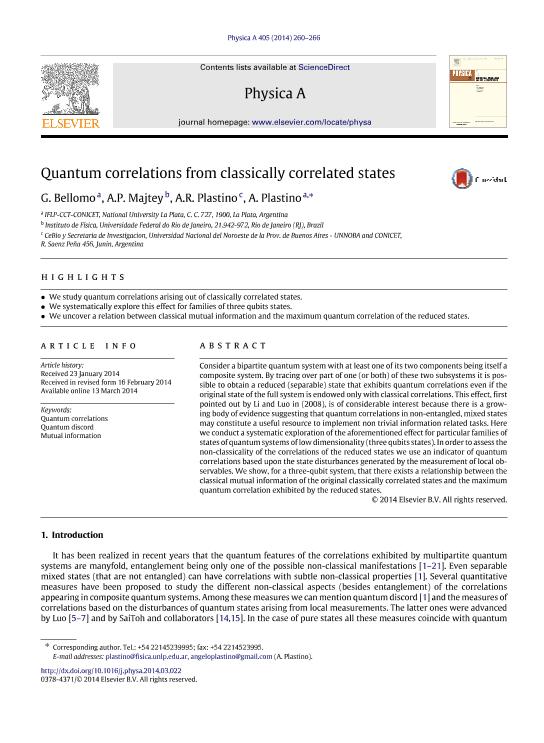Artículo
Quantum correlations from classically correlated states
Fecha de publicación:
07/2014
Editorial:
Elsevier Science
Revista:
Physica A: Statistical Mechanics and its Applications
ISSN:
0378-4371
Idioma:
Inglés
Tipo de recurso:
Artículo publicado
Clasificación temática:
Resumen
Consider a bipartite quantum system with at least one of its two components being itself a composite system. By tracing over part of one (or both) of these two subsystems it is possible to obtain a reduced (separable) state that exhibits quantum correlations even if the original state of the full system is endowed only with classical correlations. This effect, first pointed out by Li and Luo in (2008), is of considerable interest because there is a growing body of evidence suggesting that quantum correlations in non-entangled, mixed states may constitute a useful resource to implement non trivial information related tasks. Here we conduct a systematic exploration of the aforementioned effect for particular families of states of quantum systems of low dimensionality (three qubits states). In order to assess the non-classicality of the correlations of the reduced states we use an indicator of quantum correlations based upon the state disturbances generated by the measurement of local observables. We show, for a three-qubit system, that there exists a relationship between the classical mutual information of the original classically correlated states and the maximum quantum correlation exhibited by the reduced states.
Palabras clave:
Quantum Correlations
,
Quantum Discord
,
Mutual Information
Archivos asociados
Licencia
Identificadores
Colecciones
Articulos(IFLP)
Articulos de INST.DE FISICA LA PLATA
Articulos de INST.DE FISICA LA PLATA
Articulos(SEDE CENTRAL)
Articulos de SEDE CENTRAL
Articulos de SEDE CENTRAL
Citación
Bellomo, Guido; Majtey, Ana Paula; Plastino, Ángel Ricardo; Plastino, Ángel Ricardo; Quantum correlations from classically correlated states; Elsevier Science; Physica A: Statistical Mechanics and its Applications; 405; 7-2014; 260-266
Compartir
Altmétricas




